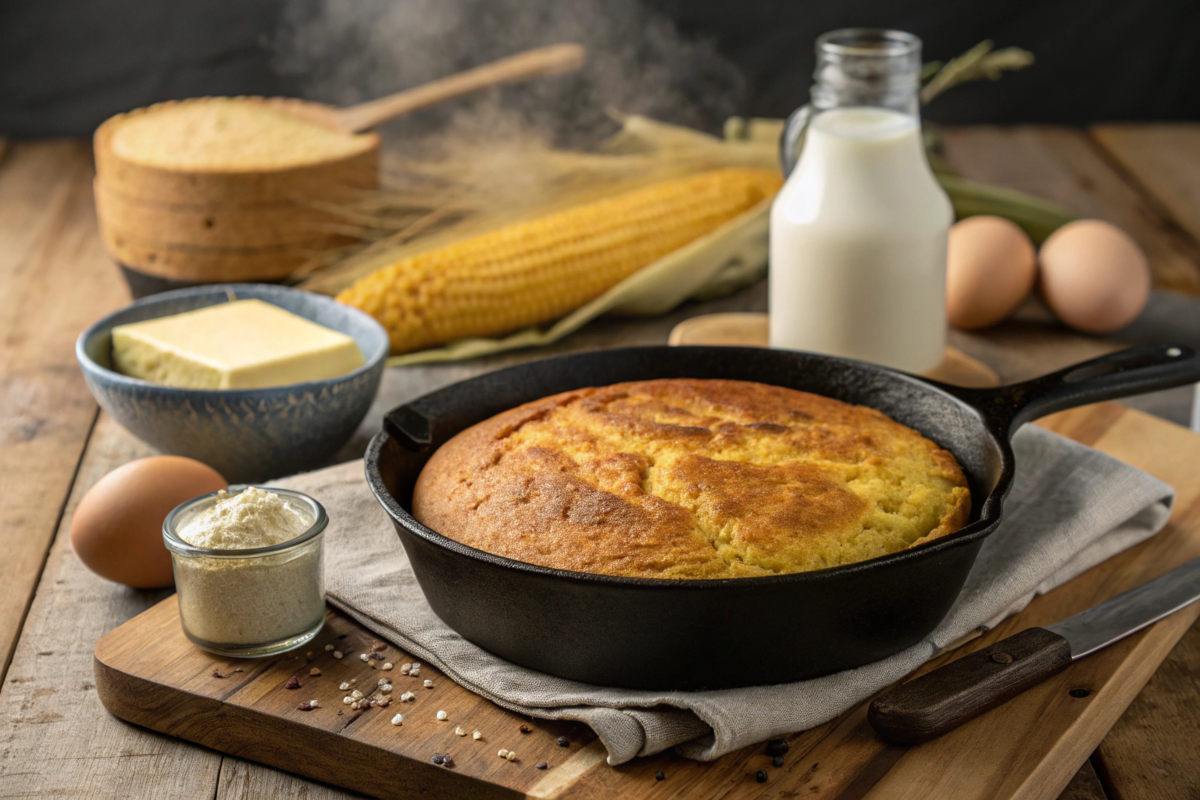Cornbread is more than just a side dish in the South—it’s a symbol of comfort, tradition, and family gatherings. This article dives deep into the southern cornbread recipe, from its rich history to its perfect preparation, with tips and variations to suit every palate. Whether you’re a seasoned cook or new to Southern cuisine, you’ll discover everything you need to master this beloved dish.
Introduction to Southern Cornbread
The History of Southern Cornbread
Southern cornbread has its roots in Native American cooking, where ground cornmeal was a dietary staple. Over time, settlers adapted the dish to their resources, transforming it into a quick bread beloved across the region. The absence of sugar in traditional southern cornbread reflects its humble origins—simple, savory, and utterly satisfying.
Why Southern Cornbread Stands Out
Unlike its sweeter, cakier Northern cousin, Southern cornbread is unapologetically rustic. It’s known for its golden crust, fluffy interior, and savory flavor, often enhanced by buttermilk and a generous amount of fat—typically bacon grease or butter. Served hot from a cast iron skillet, it’s the quintessential comfort food.
Overview of the Recipe: Key Ingredients and Technique
The magic of a southern cornbread recipe lies in its simplicity. With just a handful of pantry staples—cornmeal, buttermilk, eggs, and fat—you can whip up a dish that’s both versatile and delicious. The secret? Preheating the skillet to create a crispy, golden crust that contrasts beautifully with the tender interior.
Traditional Southern Cornbread Recipe
Ingredients You’ll Need
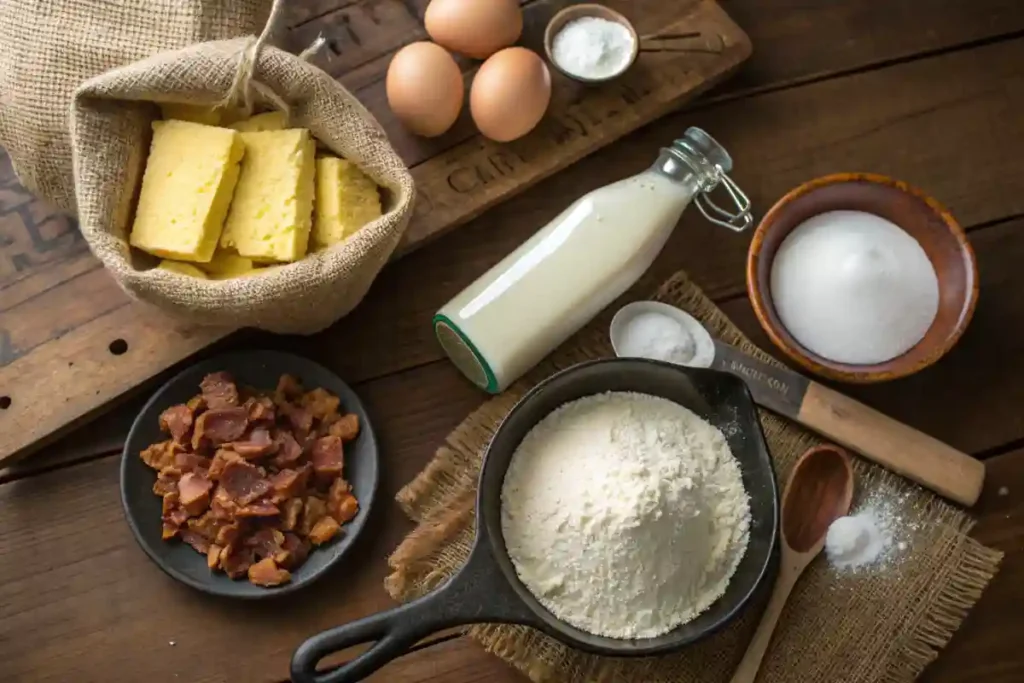
To whip up the perfect southern cornbread recipe, simplicity is key. Here’s what you’ll need:
- Cornmeal: The heart of the recipe, opt for stone-ground for a rustic texture.
- Buttermilk: Adds tanginess and helps achieve a moist crumb.
- Eggs: For binding and fluffiness.
- Bacon grease or butter: Provides richness and a golden crust.
Step-by-Step Preparation Guide
- Preheat the oven: Heat your cast iron skillet inside the oven at 425°F. This creates that iconic crispy crust.
- Mix dry ingredients: Combine cornmeal, a pinch of salt, and baking soda in a bowl.
- Blend wet ingredients: Whisk together buttermilk, eggs, and melted butter or bacon grease.
- Combine and pour: Mix wet and dry ingredients until just combined, then pour the batter into the sizzling skillet.
- Bake to perfection: Cook for 20-25 minutes until the top is golden brown and a toothpick comes out clean.
Tips for Achieving Perfect Texture
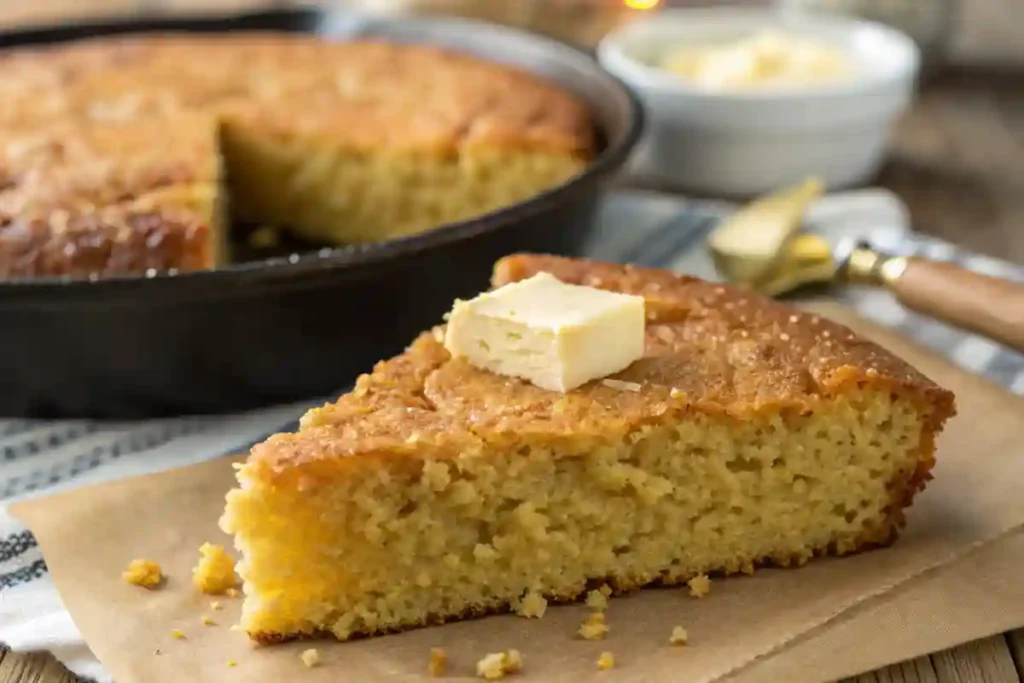
- Don’t overmix: Stirring too much can make the bread dense.
- Use a hot skillet: Pouring batter into a preheated skillet ensures a crunchy crust.
- Adjust fat content: A little extra butter can make the cornbread richer, while bacon grease amps up the flavor.
Regional Variations of Southern Cornbread
Cornbread Across the South: Subtle Differences
While the southern cornbread recipe is a staple, it varies from state to state. For example:
- Deep South cornbread leans heavily on savory flavors, often eschewing sugar entirely.
- Texan cornbread frequently incorporates jalapeños for a spicy kick.
Sweet vs. Savory: Regional Preferences
A hot debate among Southerners is whether cornbread should be sweet. In many areas of the South, sugar is considered heresy. However, some prefer a touch of sweetness to balance spicy dishes like chili.
Additions and Twists: Jalapeños, Bacon, and More
Elevate your cornbread with these creative tweaks:
- Jalapeños: Add heat and a pop of color.
- Corn kernels: For extra sweetness and texture.
- Cheese or bacon bits: Introduce richness and complexity.
Whether you stick to tradition or experiment with additions, southern cornbread remains a versatile canvas for culinary creativity.
The Science Behind Perfect Cornbread
Cornmeal Types and Their Impact on Taste
The type of cornmeal you use plays a big role in the flavor and texture of your southern cornbread recipe. Stone-ground cornmeal, for instance, has a coarser texture and richer flavor because it retains the natural oils from the corn. On the other hand, degerminated cornmeal has a finer grind and a milder taste, ideal for those who prefer a smoother crumb.
Using yellow cornmeal brings out a bright, classic color, while white cornmeal is more neutral, common in some Southern regions. Experimenting with different types can make a huge difference in your final dish!
The Role of Fats: Butter, Oil, or Bacon Grease?
Fats are critical for moist, flavorful cornbread. While butter adds richness and a slight sweetness, bacon grease is often the go-to for an authentic Southern flavor. Vegetable oil, though less traditional, provides a neutral base and keeps the bread moist.
For the best results, use a combination: bacon grease for the skillet and butter in the batter. This double approach enhances flavor and guarantees a crisp, golden crust.
Why Buttermilk is Essential
Buttermilk is a game-changer in any southern cornbread recipe. Its acidity reacts with baking soda to create a tender crumb, while its tangy flavor balances the richness of the fats. If you don’t have buttermilk on hand, you can make a quick substitute by adding a tablespoon of vinegar or lemon juice to a cup of milk.
Tips and Tricks for the Best Southern Cornbread
Common Mistakes to Avoid
- Skipping the preheated skillet: This step ensures the cornbread develops a crispy crust. Always heat the skillet in the oven before adding the batter.
- Using the wrong cornmeal: Avoid overly processed or sweetened cornmeal, as it can stray from the traditional taste.
- Overmixing the batter: Stir until just combined to prevent a dense, chewy texture.
Perfecting the Crust: Cast Iron vs. Other Methods
Cast iron skillets are iconic for a reason—they distribute heat evenly and create the perfect crust. If you don’t own a cast iron skillet, a heavy ovenproof dish can work in a pinch. However, the distinct crust might not develop as well.
For an extra crispy edge, grease the skillet generously with bacon grease and heat it in the oven for about 10 minutes before pouring in the batter.
Serving Suggestions: What Goes Well with Cornbread
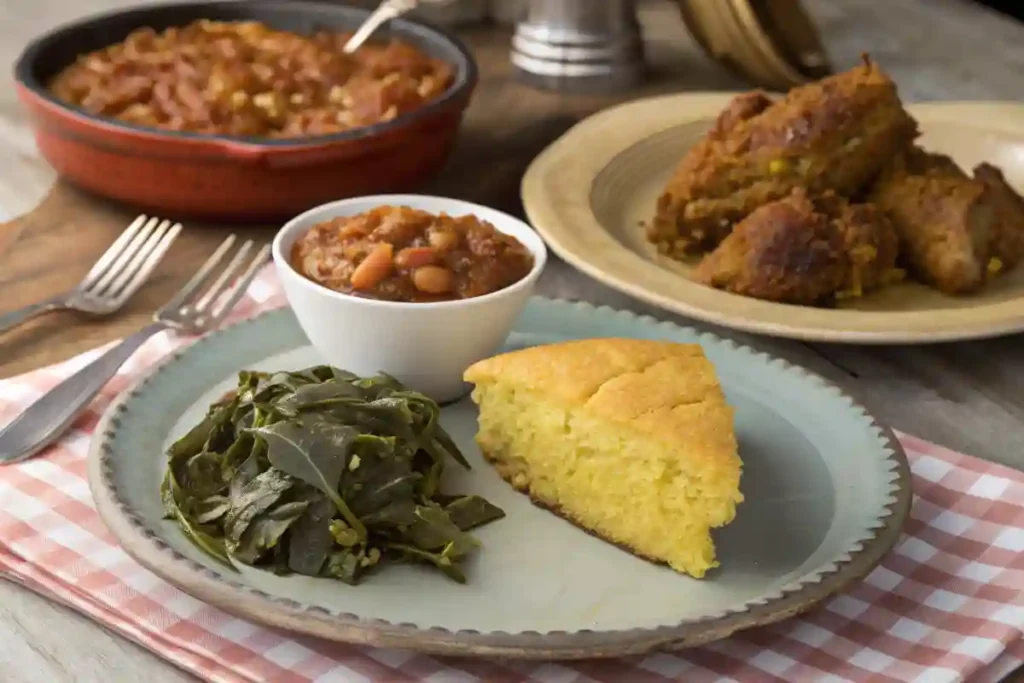
Southern cornbread is versatile and pairs beautifully with many dishes. Try it alongside chili, fried chicken, or collard greens. For a sweeter spin, drizzle it with honey or serve with a dollop of butter. The possibilities are endless!
Explore More Recipes!
For more delicious dishes, visit our recipe article. From hearty sides to savory mains, there’s something for everyone.
Part 6: FAQs About Southern Cornbread
What is the Difference Between Cornbread and Southern Cornbread?
The main distinction lies in flavor and texture. While Northern cornbread often contains sugar for sweetness, southern cornbread recipes stick to savory flavors. Southern cornbread is also more crumbly, thanks to the use of stone-ground cornmeal and the absence of flour in many traditional recipes.
Why Do Southerners Not Put Sugar in Cornbread?
In the South, cornbread is considered a savory dish, meant to complement hearty meals like stews and greens. Historically, sugar was scarce and reserved for special treats, so cornbread became a simple, unsweetened staple. Even today, many Southerners believe that sugar doesn’t belong in a southern cornbread recipe.
Is It Better to Use Milk or Buttermilk in Cornbread?
Buttermilk is the classic choice for southern cornbread recipes. It adds a tangy flavor and reacts with baking soda to make the bread fluffy. Regular milk can be used in a pinch, but it won’t provide the same depth of flavor. For best results, stick with buttermilk or create a substitute by mixing milk with a splash of vinegar.
What Do You Need for Dolly Parton Cornbread?
Dolly Parton’s famous cornbread is rich and slightly sweet, blending self-rising cornmeal, eggs, and plenty of butter. It’s an approachable twist on traditional Southern cornbread, offering a hint of sugar for balance without overpowering the savory essence.
Creative Twists on Southern Cornbread
Cornbread Muffins: Miniature Versions of a Classic
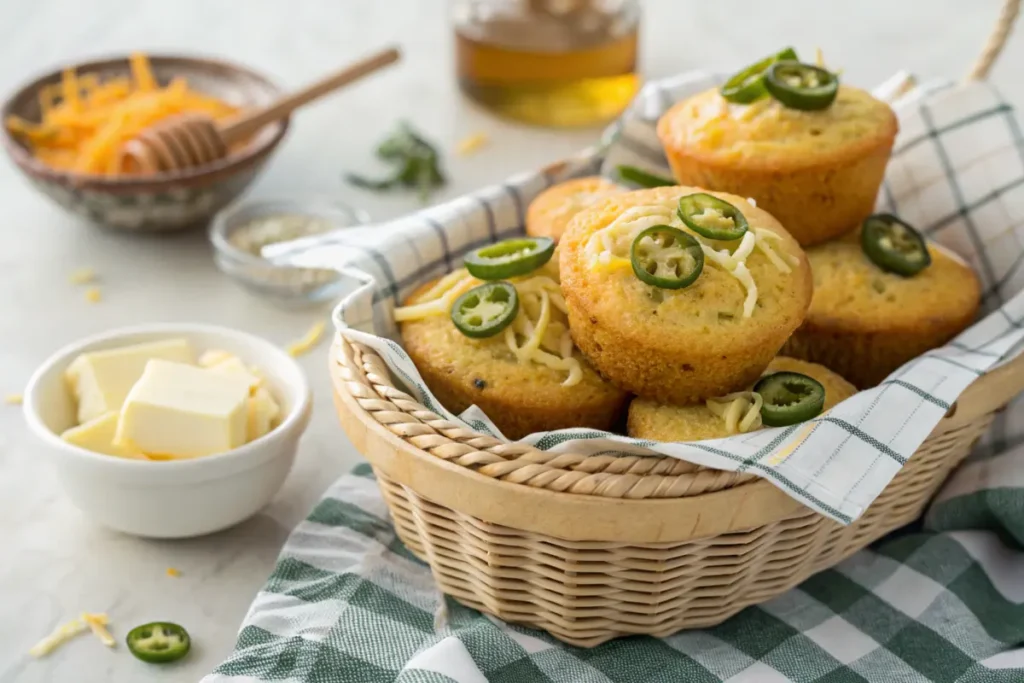
Cornbread muffins are a convenient take on the southern cornbread recipe. These bite-sized delights are perfect for parties, picnics, or quick snacks. For extra flavor, mix in ingredients like cheddar cheese or green onions. Baking them in muffin tins also ensures evenly portioned servings with a crisp, golden crust.
Mexican Cornbread: A Spicy Take
If you enjoy bold flavors, try Mexican cornbread. By adding jalapeños, corn kernels, and shredded cheese, you transform the southern cornbread recipe into a vibrant, spicy side dish. Pair it with tacos, chili, or grilled meats for a flavorful meal that packs a punch.
Sweet Cornbread: When Sugar Makes a Difference
Though not traditional in the South, sweet cornbread has its own appeal. Adding sugar or honey creates a dessert-like treat that pairs beautifully with butter or syrup. It’s a delightful way to introduce cornbread to kids or those who prefer a sweeter option.
Conclusion: Why Southern Cornbread is a Timeless Favorite
Summary of Key Takeaways
The southern cornbread recipe stands as a testament to simplicity and tradition. From its humble beginnings with just cornmeal and water to its modern-day variations, this dish has remained a staple in Southern kitchens. Whether you prefer it crumbly and savory or with a creative twist like jalapeños or honey, cornbread’s versatility ensures it has a place on every table.
What makes Southern cornbread so special isn’t just its golden crust or tender interior—it’s the way it brings people together. It’s served at family gatherings, potlucks, and celebrations, becoming a shared experience that transcends generations.
Encouragement to Try Your Own Twist
Now that you’ve learned the ins and outs of the southern cornbread recipe, it’s time to roll up your sleeves and try it for yourself. Stick to tradition or put your own spin on it—the choice is yours. With its forgiving nature and endless adaptability, cornbread invites creativity while holding onto its rich roots. Don’t be afraid to experiment and make this classic dish your own.
FAQs About Southern Cornbread
What Are the Nutritional Benefits of Cornbread?
Cornbread, made primarily of cornmeal, is naturally gluten-free and rich in carbohydrates, making it a good source of energy. When prepared with buttermilk, it also contains calcium and protein. However, its nutritional profile can vary depending on added ingredients like cheese, sugar, or bacon grease.
How Do You Store Cornbread for Freshness?
To keep your southern cornbread recipe fresh, store it in an airtight container at room temperature for up to two days. For longer storage, refrigerate it for up to a week or freeze for up to three months. Reheat in an oven to restore its crispy crust.
What Are Some Serving Ideas for Cornbread?
Cornbread pairs wonderfully with hearty dishes like chili, barbecue, or collard greens. You can also crumble it into soups or stews for added texture. For a sweeter option, serve it with butter and honey for a delightful breakfast treat.
Can I Make Cornbread Without a Cast Iron Skillet?
Yes! While a cast iron skillet is ideal for the southern cornbread recipe because of its ability to create a crispy crust, you can use an oven-safe baking dish or even a muffin tin. Just preheat your chosen dish to mimic the skillet’s effect.
With these insights, you’re now ready to embrace the rich heritage of Southern cornbread and make it a cherished part of your recipe collection.

